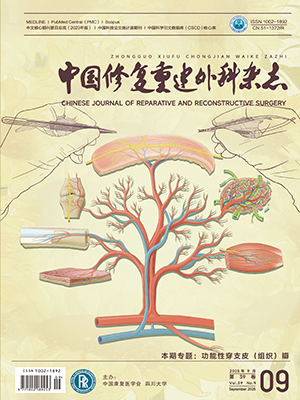| 1. |
王江宁, 高磊. 糖尿病足慢性创面治疗的新进展. 中国修复重建外科杂志, 2018, 32(7): 832-837.
|
| 2. |
Flumignan CDQ, Amaral FCF, Flumignan RLG, et al. Angioplasty and stenting for below the knee ulcers in diabetic patients: protocol for a systematic review. Syst Rev, 2018, 7(1): 228.
|
| 3. |
Soyoye DO, Abiodun OO, Ikem RT, et al. Diabetes and peripheral artery disease: A review. World J Diabetes, 2021, 12(6): 827-838.
|
| 4. |
戴兵, 戴伟. 糖尿病足下肢动脉病变血管外科治疗进展. 医学研究生学报, 2021, 34(10): 1102-1105.
|
| 5. |
Nather A, Cao S, Chen JLW, et al. Prevention of diabetic foot complications. Singapore Med J, 2018, 59(6): 291-294.
|
| 6. |
Reardon R, Simring D, Kim B, et al. The diabetic foot ulcer. Aust J Gen Pract, 2020, 49(5): 250-255.
|
| 7. |
Marco M, Valentina I, Daniele M, et al. Peripheral arterial disease in persons with diabetic foot ulceration: a current comprehensive overview. Curr Diabetes Rev, 2021, 17(4): 474-485.
|
| 8. |
中国糖尿病足细胞与介入治疗技术联盟, 中国介入医师分会介入医学与生物工程技术委员会, 国家放射与治疗临床医学研究中心. 糖尿病足介入综合诊治临床指南(第六版). 介入放射学杂志, 2020, 29(9): 853-866.
|
| 9. |
Rykowska I, Nowak I, Nowak R. Drug-eluting stents and balloons-materials, structure designs, and coating techniques: a review. Molecules, 2020, 25(20): 4624.
|
| 10. |
Canfield J, Totary-Jain H. 40 years of percutaneous coronary intervention: history and future directions. J Pers Med, 2018, 8(4): 33.
|
| 11. |
Hu T, Yang C, Lin S, et al. Biodegradable stents for coronary artery disease treatment: Recent advances and future perspectives. Mater Sci Eng C Mater Biol Appl, 2018, 91: 163-178.
|
| 12. |
Byrne RA, Joner M, Kastrati A. Stent thrombosis and restenosis: what have we learned and where are we going? The Andreas Grüntzig Lecture ESC 2014. Eur Heart J, 2015, 36(47): 3320-3331.
|
| 13. |
Wang Y, Zhu J, Chen J, et al. The signaling pathways induced by exosomes in promoting diabetic wound healing: a mini-review. Curr Issues Mol Biol, 2022, 44(10): 4960-4976.
|
| 14. |
王江文, 易阳艳, 朱元正. MSCs来源外泌体在创面修复中的研究进展. 中国修复重建外科杂志, 2019, 33(5): 634-639.
|
| 15. |
张璟琳, 冷敏, 朱博恒, 等. 干细胞源外泌体促进糖尿病创面愈合的机制及应用. 中国组织工程研究, 2022, 26(7): 1113-1118.
|
| 16. |
Hu S, Li Z, Shen D, et al. Exosome-eluting stents for vascular healing after ischaemic injury. Nat Biomed Eng, 2021, 5(10): 1174-1188.
|
| 17. |
Anderton CR, Vaezian B, Lou K, et al. Identification of a lipid-related peak set to enhance the interpretation of TOF-SIMS data from model and cellular membranes: A lipid-related peak set for interpreting TOF-SIMS data from membranes. J Surface and Interface Analysis, 2012, 44(3): 322-333.
|
| 18. |
Nandan S, Schiavi-Tritz J, Hellmuth R, et al. Design and verification of a novel perfusion bioreactor to evaluate the performance of a self-expanding stent for peripheral artery applications. Front Med Technol, 2022, 4: 886458.
|
| 19. |
Wang L, Jiao L, Pang S, et al. The development of design and manufacture techniques for bioresorbable coronary artery stents. Micromachines (Basel), 2021, 12(8): 990.
|
| 20. |
Liu R, Xu S, Luo X, et al. Theoretical and numerical analysis of mechanical behaviors of a metamaterial-based shape memory polymer stent. Polymers (Basel), 2020, 12(8): 1784.
|
| 21. |
国家药品监督管理局. 球囊扩张和自扩张血管支架的径向载荷测试方法 YY/T1660-2019. 北京: 中国标准出版社, 2019.
|




